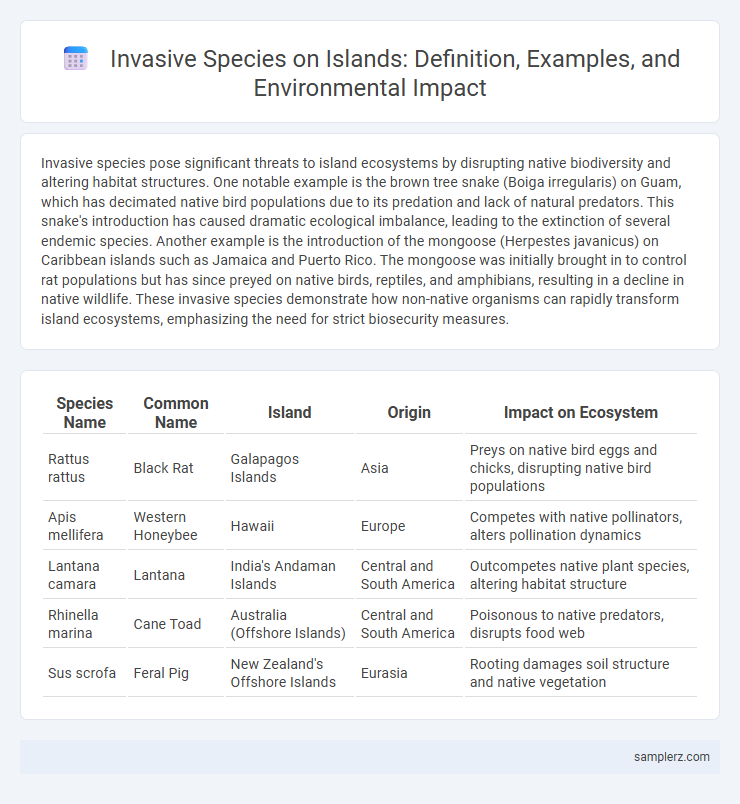Invasive species pose significant threats to island ecosystems by disrupting native biodiversity and altering habitat structures. One notable example is the brown tree snake (Boiga irregularis) on Guam, which has decimated native bird populations due to its predation and lack of natural predators. This snake's introduction has caused dramatic ecological imbalance, leading to the extinction of several endemic species. Another example is the introduction of the mongoose (Herpestes javanicus) on Caribbean islands such as Jamaica and Puerto Rico. The mongoose was initially brought in to control rat populations but has since preyed on native birds, reptiles, and amphibians, resulting in a decline in native wildlife. These invasive species demonstrate how non-native organisms can rapidly transform island ecosystems, emphasizing the need for strict biosecurity measures.
Table of Comparison
| Species Name | Common Name | Island | Origin | Impact on Ecosystem |
|---|---|---|---|---|
| Rattus rattus | Black Rat | Galapagos Islands | Asia | Preys on native bird eggs and chicks, disrupting native bird populations |
| Apis mellifera | Western Honeybee | Hawaii | Europe | Competes with native pollinators, alters pollination dynamics |
| Lantana camara | Lantana | India's Andaman Islands | Central and South America | Outcompetes native plant species, altering habitat structure |
| Rhinella marina | Cane Toad | Australia (Offshore Islands) | Central and South America | Poisonous to native predators, disrupts food web |
| Sus scrofa | Feral Pig | New Zealand's Offshore Islands | Eurasia | Rooting damages soil structure and native vegetation |
Overview of Invasive Species Impact on Islands
Invasive species like the brown tree snake in Guam have devastated native bird populations, causing significant ecological imbalance on islands. These species often outcompete or prey on native flora and fauna, leading to loss of biodiversity and altered ecosystem functions. Island ecosystems, characterized by their isolated evolution, are particularly vulnerable to such invasive species impacts, frequently resulting in irreversible environmental damage.
Notorious Invasive Plants on Oceanic Islands
Miconia calvescens, often called the "green cancer," aggressively dominates native forests on oceanic islands like Tahiti, outcompeting endemic plants and disrupting local ecosystems. Another notorious invasive is the Himalayan blackberry, which forms dense thickets that prevent native species regeneration and alter habitat structure. These invasive plants significantly threaten biodiversity and contribute to soil erosion and habitat loss on vulnerable island ecosystems.
Animal Invaders: Mammals Disrupting Island Ecosystems
Invasive mammal species such as rats, cats, and goats have severely disrupted island ecosystems by preying on native wildlife and competing for scarce resources. Rats often decimate bird populations by consuming eggs and chicks, while feral cats introduce predation pressure that native species are unadapted to withstand. Goats cause extensive vegetation loss, leading to habitat degradation and decreased biodiversity on islands worldwide.
Problematic Birds Introduced to Island Habitats
The introduction of invasive bird species like the common myna (Acridotheres tristis) has severely disrupted island ecosystems by outcompeting native birds for food and nesting sites. These birds often carry diseases that native species lack immunity against, leading to population declines and loss of biodiversity. Their aggressive behavior alters the natural balance, threatening endemic bird species and the overall health of island habitats.
Invasive Reptiles Threatening Native Island Species
Invasive reptiles such as the brown tree snake (Boiga irregularis) on Guam have caused dramatic declines in native bird populations and disrupted local ecosystems. These snakes prey on eggs, birds, and small mammals, leading to the extinction of several endemic species. Effective management and prevention strategies are critical to protect island biodiversity from the ecological damage caused by invasive reptile species.
Aquatic Invaders: Non-Native Species in Island Waters
In island ecosystems, invasive aquatic species such as the lionfish (Pterois volitans) and the green mussel (Perna viridis) disrupt native biodiversity by preying on indigenous fish and outcompeting local shellfish. These non-native species alter food webs and degrade coral reef health, leading to declines in endemic populations and fishery yields. Effective management strategies include targeted removal and public awareness campaigns to prevent further spread in island waters.
Invasive Insects and the Collapse of Island Biodiversity
Invasive insects such as the brown tree snake on Guam have caused drastic declines in native bird populations, leading to significant disruptions in island ecosystems and the collapse of biodiversity. These predatory insects often lack natural enemies on islands, allowing their populations to explode and outcompete or prey on endemic species. The resulting ecological imbalance threatens pollination networks, seed dispersal, and overall habitat integrity critical for island biodiversity conservation.
Successful Island Invasive Species Eradication Projects
The eradication of invasive species like rats on South Georgia Island represents a landmark success in island conservation, restoring native bird populations and ecosystem balance. Project teams implemented extensive baiting campaigns and rigorous monitoring to eliminate invasive rodents, resulting in measurable increases in seabird breeding success. This example highlights the effectiveness of specialized strategies in achieving complete invasive species removal on ecologically sensitive islands.
Economic and Social Costs of Invasive Species on Islands
The introduction of invasive species like rats and brown tree snakes on islands such as Guam has led to significant economic costs by damaging native crops and fisheries, undermining local livelihoods. These species disrupt ecosystems, causing the extinction of native bird populations, which alters ecological balance and threatens cultural heritage tied to native biodiversity. Social costs arise from increased public health risks and reduced tourism revenue, impacting island communities' economic stability and quality of life.
Prevention Strategies for Invasive Species on Islands
Invasive species such as the brown tree snake on Guam and the black rat on New Zealand islands jeopardize native biodiversity and ecosystem stability. Prevention strategies include rigorous biosecurity measures like quarantine protocols, early detection systems, and public awareness campaigns to reduce accidental introductions. Implementing strict shipping and cargo inspections, combined with rapid response teams, enhances the ability to intercept invasive species before they establish populations.

example of invasive species in island Infographic
 samplerz.com
samplerz.com